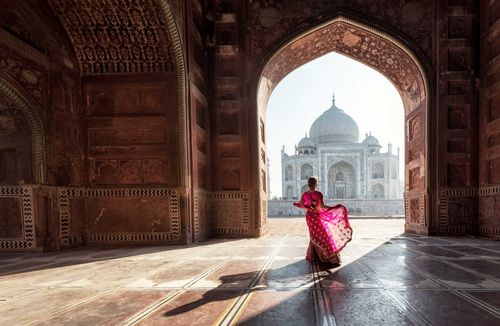Budget accommodation
While accommodation prices in India are generally on the up, there’s still an abundance of inexpensive hotels and hostels, catering for foreign backpackers, tourists and less well-off Indians. The rock-bottom option is usually in a dormitory of a hostel or lodge. Even cheaper still are dharamshalas, hostels run by religious establishments and used by pilgrims.
Budget accommodation varies from filthy fleapits to homely guesthouses and, naturally, tends to be cheaper the further you get off the beaten track. It’s most expensive in Delhi, Mumbai, Goa and resorts of Kerala, where prices are at least double those for equivalent accommodation in most other parts of the country.
The cheapest rooms usually have flimsy beds and thin, lumpy mattresses. Most places now offer en-suite bathrooms (or “attached” rooms, as they’re known locally) and hot water, either on tap or in a bucket, though shared showers and toilets with only cold water are still fairly common at the bottom of the range – in our reviews in the Guide we have assumed that establishments have attached rooms and noted exceptions. It’s always wise to check out the state of the bathrooms and toilets before taking a room. Bedbugs and mosquitoes are other things to check for – splotches of blood around the bed and on the walls where people have squashed them are telltale signs.
If a taxi or rickshaw driver tells you that the place you ask for is full, closed or has moved, it’s more than likely that it’s because he wants to take you to a hotel that pays him commission – added, in some cases, to your bill. Hotel touts operate in many popular tourist spots, working for commission from the hotels they take you to; this can become annoying and they should be given a wide berth unless you are desperate.
Mid-range hotels
Even if you value your creature comforts, you don’t need to pay through the nose for them. Extras that bump up the price include local taxes, a TV, mosquito nets, a balcony and, above all, air-conditioning. Abbreviated as a/c, air-conditioning is not necessarily the advantage you might expect – in some hotels you can find yourself paying double for a system that is so dust-choked and noisy as to be more of a drawback than an advantage. Some offer air-coolers instead of a/c – these can be noisy and are less effective than full-blown a/c, but much better than just a fan. They’re only found in drier climes as they don’t work in areas of extreme humidity such as along the coasts of south India and the Bay of Bengal. Many medium-priced hotels also have attached restaurants, and also offer room service.
Most state governments run their own chain of hotels. They are usually good value but far less well run than comparable places in the private sector. Bookings for state-run hotels can be made in advance through the state tourist offices throughout the country.
Upmarket hotels
Recent years have seen a proliferation in the number of luxury hotels throughout India. Roughly speaking they fall into three categories. Pitched primarily at visiting businessmen, smart, Western-style hotels with air-conditioning and swanky interiors are to be found predominantly in towns and city centres. Because competition among them is rife, tariffs tend to represent good value for money, especially in the upper-mid-range bracket. Formal five-star chains such as Taj, India’s premier hotel group, charge international rates – as most of their guests are on expense accounts or staying as part of discounted tour packages. Note that many top-end hotels offer significant reductions to their rack rates if you book online.
Holding more appeal for foreign visitors are the heritage properties that have mushroomed all across the country in recent years. Rajasthan started the trend, with old forts, palaces, hunting lodges, havelis and former hunting camps converted into accommodation for high-spending tourists. Brimming with old-world atmosphere, they deliver a quintessentially Indian “experience”, often in the most exotic locations, with turbaned bellboys and antique automobiles adding to the colonial-era ambience. Other states were quick to get in on the act, and these days you can stay in fabulous Tamil mansions, colonial tea bungalows in Coorg or the Nilgiris, wooden, gabled-roofed tharavadus (ancestral homes) in the Keralan backwaters and Portuguese palacios in Goa. Quite a few wildlife sanctuaries also offer atmospheric, high-end accommodation in former hunting lodges, tented camps or treehouses, while down in Kerala, you can experience the lakes and lagoons of the backwaters on a converted rice barge.
The third category, which is gaining in popularity in cities and touristic areas, is boutique hotels, modelled on Western lines. With much less of a corporate feel than business hotels, these tend to be smaller and place a greater emphasis on service and modern design features,; some may occupy heritage properties.
Other options
Unsurprisingly, India has fully embraced the new global sharing economy and it’s increasingly possible to find great places to stay via websites such as Airbnb and Couchsurfing. Servas, established in 1951-52 as a peace organization, is also devoted to providing places in people’s homes, representing more than six hundred hosts in India; you have to join before travelling by applying to the local Servas secretary (via the website).Homestays, often as organized as hotels but with a far more personal touch, have been established for some time in places like Mumbai, Goa and Kerala. These have now spread far and wide, encompassing other states such as parts of Himachal Pradesh, Ladakh, Karnataka and Tamil Nadu. Farmstays, rural villas and ecolodges have also all mushroomed in popularity in recent years. None of these options are cheap, but all aim to provide a more authentic experience, whether that is the chance to literally feel part of the family or to learn something about the local wildlife and environment, or even to participate in projects.
YMCAs and YWCAs, mostly confined to big cities, can be plusher and pricier than mid-range hotels. They are usually good value but are often full and some are exclusively single-sex. Official and non-official youth hostels, some run by state governments, are spread haphazardly across the country. They give HI cardholders a discount but rarely exclude non-members, nor do they usually impose daytime closing. Prices match the cheapest hotels; where there is a youth hostel, it usually has a dormitory and may well be the best budget accommodation available – which goes especially for the Salvation Army ones. A more modern, Western-style breed of hostels has started popping up in major cities and tourist destinations from Rajasthan to Tamil Nadu. These are aimed directly at backpackers and tend to provide better facilities than the old-style hostels, as well as pleasant communal areas ideal for socializing. One of the most widespread chains is Zostel.
Camping is generally restricted to wildlife reserves, where the Forest Department lay on low-impact accommodation under canvas for visitors, and to beach resorts in which building is restricted by local coastal protection laws. Except on mountain treks, it’s not usual simply to pitch a tent in the countryside. In some mountain areas, however, there are surprisingly upmarket tent camps, which provide spacious and luxurious options for staying in the great outdoors.
Many railway stations have “retiring rooms”: basic private rooms with a bed and bathroom (some stations have dorms, too). They can be handy if you’re catching an early morning train, and are usually among the cheapest accommodation available anywhere, but can be noisy. Retiring rooms cannot be booked in advance and are allocated on a first-come-first-served basis; just turn up and ask if there’s a vacancy.
Finally, religious institutions, particularly Sikh gurudwaras, offer accommodation for pilgrims and visitors, which may include tourists; a donation is often expected, and certainly appreciated, but some of the bigger ones charge a fixed, nominal fee. Pilgrimage sites, especially those far from other accommodation, also have dharamshalas where visitors can stay – very cheap and very simple, usually with basic, communal washing facilities; some charitable institutions even have rooms with simple attached bathrooms. Dharamshalas, like gurudwaras, offer accommodation either on a donations system or charge a nominal fee.















